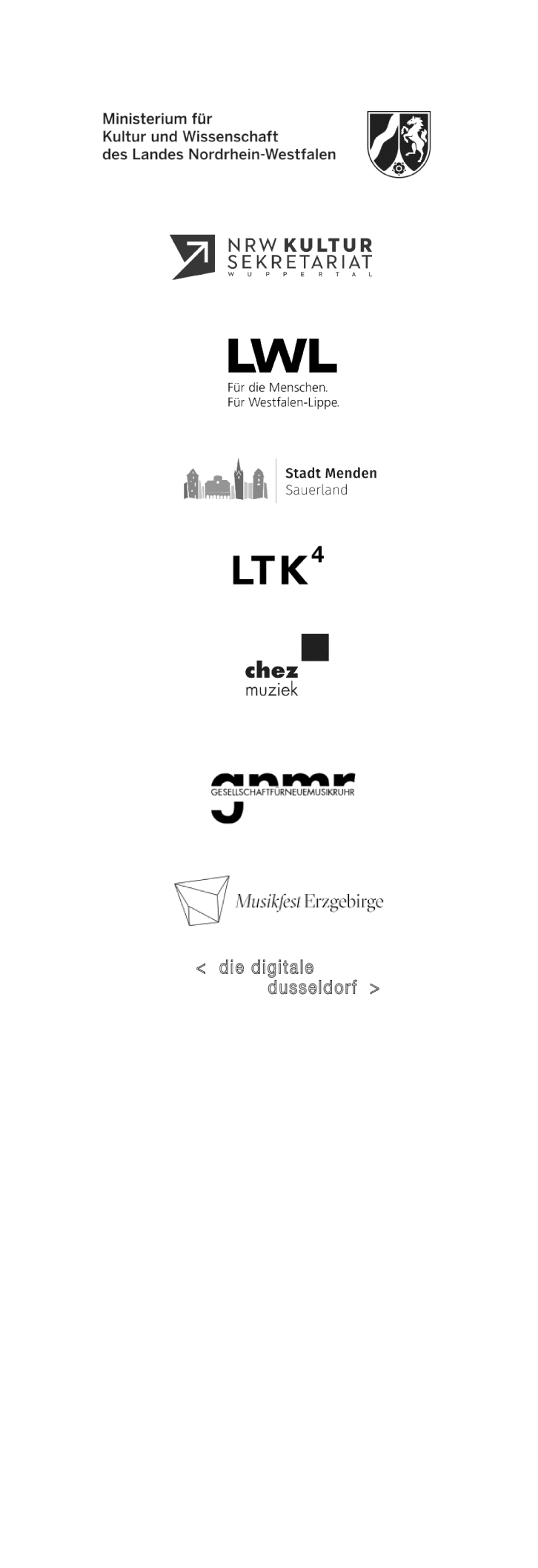 |
|||||
 |
|||||
 |
|||||
| ROCHUS AUST/1. GERMAN ELECTROPHONIC ORCHESTRA DIGITAL FREEZE TRIO RE-ENSOUNDMENT/4-AV-VERSION Digital simultaneous performance on 4 video and 8 audio channels 28.06.2020 · 20.00h (german time) 29.06.2020 · 06.00h (NZ time) Technical Notes: This performance can take place at a location of your choosing (although the public space is not recommended). You need 4 audio-visual gadgets and a stable internet connection. The gadgets can range from computers to tablets to smartphones. The combination of gadgets is open for you to decide. Position the gadgets as far as possible from each other in your chosen space (for example in the four corners of the room, not necessarily symmetrical, though). The visual screen of the gadget should be directed to the center of the space. Turn up the audio volume and double check the desired loudness by using an example video from your library. Caution: the separate audio channels of this performance are not continuously sounding. But don't let the silence irritate you. That is, why adjusting the volume beforehand is recommended. Enter the video link of Channel 1 (Kanal1) on the gadget, which in your opinion offers the best sound quality in your combination. Distribute the video links Channel 2 to Channel 4 (Kanal2 to Kanal4) to your other three gadgets. If you have external speakers available, connect stereo sets to one (or possibly each) of the audio-visual gadgets. Make sure to gather the external speakers in close proximity to the assigned gadget to keep the audio localized with the video. Lastly, position yourself (as well as your co-listeners/-viewers) in the centre of the room. RE-ENSOUNDMENT (4-AV-channel) Video concert 2021 Channel 1 (Kanal1) Kulturkenner · Kulturportal des Landes Nordrhein-Westfalen/D Channel 2 (Kanal2) LWL-Museum für Kunst und Kultur · Münster/D Channel 3 (Kanal3) Audio Foundation · Auckland/NZ Channel 4 (Kanal4) Gesellschaft für Neue Musik Ruhr · Essen/D Digital Freeze Trio I Tomaso Antonio Vitali · Georg Philipp Telemann · Henry Purcell feat. Junge Deutsche Philharmonie · Capella Istropolitana Bratislava 03' 55’' Digital Freeze Trio II Joseph Haydn Andante feat. Lithuanian Chamberorchestra 04' 12’' Digital Freeze Trio V Aust/Aust/Aust Horny feat. Song & Dance Brigade 02' 31’' 1. GERMAN ELECTROPHONIC ORCHESTRA Rochus Aust (Troaxofon/Trumpet/Electr. devices) Heinz Friedl (Bass clarinet/Electr. devices) Florian Zwissler (Synthesizer/Electr. devices) Fosco Perinti (Voice/Electr. devices) Mark Polscher (Synthesizer/Electr. devices) Gilbert Nouno (Synthesizer/Electr. devices) Verena Barié (Recorder/Electr. devices) Markus Aust (Sound design/Hawaii-Guitar/Sound direction) Video · concept/recording/camera/editing - Jan Verbeek/Rochus Aust and 1. GERMAN ELECTROPHONIC ORCHESTRA Recorded in Düsseldorf (07.11.2020 · die digitale/Berger Kirche) and in Münster (10.-11.01.2021 · LWL-Museum für Kunst und Kultur) all music courtesy of chez muziek ROCHUS AUST/DIGITAL FREEZE TRIO RE-ENSOUNDMENT 30.07.2020 · Köln · Centre Court Festival 08.09.2020 · Menden · Kunstfest Passagen 12.09.2020 · Schwarzenberg · Musikfest Erzgebirge/Deutschlandfunk 13.09.2020 · Essen · nano#drei Festival 07.11.2020 · Düsseldorf · Digitale 17.11.2020 · Münster · LWL-Museum für Kunst und Kultur 16.04.2021 · extra.resonance.fm · funkt DIGITAL VEGETATIVE STATE While hardware becomes obsolete or dies, data tends to stay preserved without being corrupted and – at least theoretically – can be resurrected. This process does not necessarily have to happen by taking giant leaps (e.g. analogue – digital), but can already kick in when there are just some minor changes: an extensive update, a groundbreaking new software, a more showy new mobile phone or a computer with increased processing power can instantly send large volumes of data into a digital vegetative state. This data might remind us of its existence, but it no longer speaks to us. This moment, which can be the result of a whole variety of motivations, is the first step towards the DIGITAL FREEZE. Be it sheer laziness or carelessness (initially, we might still be able to recover the data with relatively little effort), accident or miscalculation regarding the quality of the data: accessing it becomes increasingly difficult the more time passes, ultimately resulting in a home-made locked-in syndrome of images, texts, music and communication. DIGITAL FREEZE Leaving the analogue world has undoubtedly created the biggest (and most collective) DIGITAL FREEZE, where masses and masses of photographs, documents and files, records, sound tapes and analogue media of any kind were banished to no idea where. This point in time might have been gigantic when it comes to volumes but it was nonetheless manageable and as such comprehensible, conceivable and thus controllable. During each subsequent DIGITAL FREEZE the enormous increase in data volume also comes into play as the x variable. As recently as the 1970s, man flew to the moon with the data capacity of a simple Atari computer. Pac man would not have come along and we ourselves lack the imagination to do so. Digital data weighs next to nothing, it can be hidden in folders that all look the same and which are, for the most part, stored in state of maximum dis/order as the search for it, initially, appears so easy. Due to the constant change and evolution, we are only really able to develop a feel for data quantities in our respective, present now. Looking back or even ahead is almost impossible. To date, the story of a personal DIGITAL FREEZE cannot really be told as a universally valid story as the content of the quantities of data is at least as diverse as the individual quantities of data quantity. And therefore it offers an outstanding platform for a (digital) artistic exploration of hard and software with regard to culture and its protagonists. |
|||||